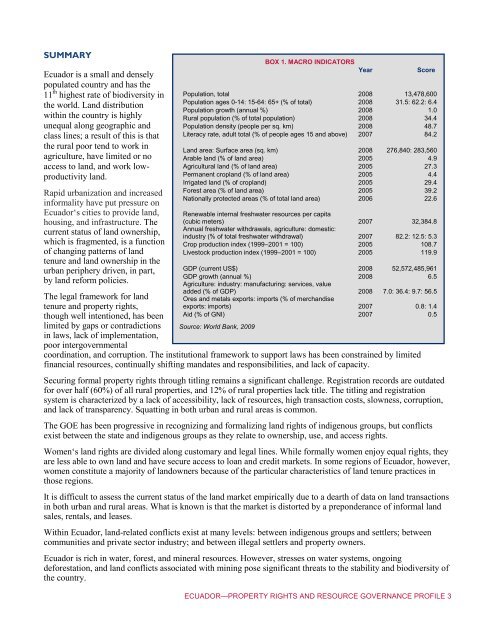ECUADOR - Land Tenure and Property Rights Portal
ECUADOR - Land Tenure and Property Rights Portal
ECUADOR - Land Tenure and Property Rights Portal
Create successful ePaper yourself
Turn your PDF publications into a flip-book with our unique Google optimized e-Paper software.
SUMMARYEcuador is a small <strong>and</strong> denselypopulated country <strong>and</strong> has the11 th highest rate of biodiversity inthe world. <strong>L<strong>and</strong></strong> distributionwithin the country is highlyunequal along geographic <strong>and</strong>class lines; a result of this is thatthe rural poor tend to work inagriculture, have limited or noaccess to l<strong>and</strong>, <strong>and</strong> work lowproductivityl<strong>and</strong>.Rapid urbanization <strong>and</strong> increasedinformality have put pressure onEcuador‘s cities to provide l<strong>and</strong>,housing, <strong>and</strong> infrastructure. Thecurrent status of l<strong>and</strong> ownership,which is fragmented, is a functionof changing patterns of l<strong>and</strong>tenure <strong>and</strong> l<strong>and</strong> ownership in theurban periphery driven, in part,by l<strong>and</strong> reform policies.The legal framework for l<strong>and</strong>tenure <strong>and</strong> property rights,though well intentioned, has beenlimited by gaps or contradictionsin laws, lack of implementation,poor intergovernmentalBOX 1. MACRO INDICATORScoordination, <strong>and</strong> corruption. The institutional framework to support laws has been constrained by limitedfinancial resources, continually shifting m<strong>and</strong>ates <strong>and</strong> responsibilities, <strong>and</strong> lack of capacity.Securing formal property rights through titling remains a significant challenge. Registration records are outdatedfor over half (60%) of all rural properties, <strong>and</strong> 12% of rural properties lack title. The titling <strong>and</strong> registrationsystem is characterized by a lack of accessibility, lack of resources, high transaction costs, slowness, corruption,<strong>and</strong> lack of transparency. Squatting in both urban <strong>and</strong> rural areas is common.The GOE has been progressive in recognizing <strong>and</strong> formalizing l<strong>and</strong> rights of indigenous groups, but conflictsexist between the state <strong>and</strong> indigenous groups as they relate to ownership, use, <strong>and</strong> access rights.Women‘s l<strong>and</strong> rights are divided along customary <strong>and</strong> legal lines. While formally women enjoy equal rights, theyare less able to own l<strong>and</strong> <strong>and</strong> have secure access to loan <strong>and</strong> credit markets. In some regions of Ecuador, however,women constitute a majority of l<strong>and</strong>owners because of the particular characteristics of l<strong>and</strong> tenure practices inthose regions.It is difficult to assess the current status of the l<strong>and</strong> market empirically due to a dearth of data on l<strong>and</strong> transactionsin both urban <strong>and</strong> rural areas. What is known is that the market is distorted by a preponderance of informal l<strong>and</strong>sales, rentals, <strong>and</strong> leases.Within Ecuador, l<strong>and</strong>-related conflicts exist at many levels: between indigenous groups <strong>and</strong> settlers; betweencommunities <strong>and</strong> private sector industry; <strong>and</strong> between illegal settlers <strong>and</strong> property owners.Ecuador is rich in water, forest, <strong>and</strong> mineral resources. However, stresses on water systems, ongoingdeforestation, <strong>and</strong> l<strong>and</strong> conflicts associated with mining pose significant threats to the stability <strong>and</strong> biodiversity ofthe country.YearScorePopulation, total 2008 13,478,600Population ages 0-14: 15-64: 65+ (% of total) 2008 31.5: 62.2: 6.4Population growth (annual %) 2008 1.0Rural population (% of total population) 2008 34.4Population density (people per sq. km) 2008 48.7Literacy rate, adult total (% of people ages 15 <strong>and</strong> above) 2007 84.2<strong>L<strong>and</strong></strong> area: Surface area (sq. km) 2008 276,840: 283,560Arable l<strong>and</strong> (% of l<strong>and</strong> area) 2005 4.9Agricultural l<strong>and</strong> (% of l<strong>and</strong> area) 2005 27.3Permanent cropl<strong>and</strong> (% of l<strong>and</strong> area) 2005 4.4Irrigated l<strong>and</strong> (% of cropl<strong>and</strong>) 2005 29.4Forest area (% of l<strong>and</strong> area) 2005 39.2Nationally protected areas (% of total l<strong>and</strong> area) 2006 22.6Renewable internal freshwater resources per capita(cubic meters) 2007 32,384.8Annual freshwater withdrawals, agriculture: domestic:industry (% of total freshwater withdrawal) 2007 82.2: 12.5: 5.3Crop production index (1999–2001 = 100) 2005 108.7Livestock production index (1999–2001 = 100) 2005 119.9GDP (current US$) 2008 52,572,485,961GDP growth (annual %) 2008 6.5Agriculture: industry: manufacturing: services, valueadded (% of GDP) 2008 7.0: 36.4: 9.7: 56.5Ores <strong>and</strong> metals exports: imports (% of merch<strong>and</strong>iseexports: imports) 2007 0.8: 1.4Aid (% of GNI) 2007 0.5Source: World Bank, 2009<strong>ECUADOR</strong>—PROPERTY RIGHTS AND RESOURCE GOVERNANCE PROFILE 3
















